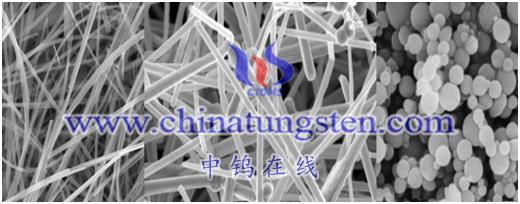Tungsten oxide is a powder metallurgy raw material for the production of cemented carbide and tungsten products. Manufacture tungsten carbide, cemented carbide, superhard molds, tungsten bars, tungsten wires, etc. by powder metallurgy, and can also be used for X-ray screens and fireproof fabrics, as well as colorants and analytical reagents for ceramics.
The color of tungsten oxide, in the W-O system, there are tungsten oxides such as WO3, WO 2.9, WO 2.72, and WO2. WO3 (yellow) — WO 2.90 (blue) – WO 2.72, (purple) – WO2 (brown) – W (gray black). That is, tungsten has four stable oxides: yellow oxide (WO3), blue oxide (WO2.90), purple oxide (WO2.72) and brown oxide (WO2).
Blue tungsten oxide refers to a series of anisotropic oxides of tungsten. The chemical formula is represented by WOx, mainly WO2.9. Blue tungsten oxide is used to produce tungsten powder, doped tungsten powder, tungsten rod and hard alloy, anti-ultraviolet, photocatalysis, etc. Blue tungsten oxide will change color when exposed to light, and will turn into a light blue. If it is repacked in a black opaque bag, it will return to its original color.
Tungsten trioxide is a lemon yellow powder with a density of 7.2~7.4g/cm3, a melting point of about 1470°C, and a boiling point of 1700~2000°C. When it is higher than 800°C, it sublimates significantly, and the heat of formation of tungsten trioxide is 202.8 cal/cm mol, tungstic anhydride is slightly soluble in water (0.2g/L), insoluble in all inorganic acids except hydrofluoric acid. Tungstic acid is easily soluble in caustic alkali solution (NaOH or KOH) and ammonia water to form tungstate [NaWO4, K2WO4 and (NH4)2WO4]. Tungsten trioxide dissolves slowly in ammonia solution, and dissolves more slowly when heated to high temperature. Tungsten trioxide is easily reduced by various reducing agents. At normal temperature, even a small amount of organic matter can restore it and change its color. But it returns to its original color when heated in air. At 700~900℃, tungsten trioxide is easily reduced to metal tungsten by hydrogen, carbon monoxide and carbon.
Tungsten Dioxide is a tan chocolate-like powder that is sensitive to moisture. When heated, the color changes from light to dark, to dark orange, and returns to its original color after cooling. The density is 10.9~11.1g/cm3, the boiling point is about 1700°C, and the heat of formation is 134 kcal/mol. At 575~600°C, hydrogen reduces tungsten trioxide to form tungsten dioxide. Tungsten dioxide is insoluble in water, alkaline solution, hydrochloric acid and dilute sulfuric acid. Nitric acid can oxidize tungsten dioxide into high-valent oxides. Tungsten dioxide is quickly oxidized to tungsten trioxide in air, and turns into blue oxide when heated to 500°C in nitrogen oxide. At 1020°C, tungsten dioxide can be reduced to metal tungsten by carbon. At 250~300°C, powdery purple tungsten oxide (WO2.72) can be obtained by reducing tungsten trioxide with hydrogen or carbon monoxide and heating tungsten trioxide to 200~250°C in vacuum.

More details of tungsten oxide product, please visit website: tungsten-oxide.com
Please contact CHINATUNGSTEN for inquiry and order of tungsten oxide:
Email: sales@chinatungsten.com
Tel.: 86 592 5129595






